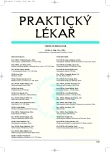Thyroid disease in the GP’s practice
Authors:
V. Zamrazil 1,2
Authors‘ workplace:
Endokrinologický ústav Praha
Ředitel: doc. MUDr. Vojtěch Hainer, CSc.
1; Subkatedra endokrinologie IPVZ, Praha
Vedoucí: prof. MUDr. Václav Zamrazil, DrSc.
2
Published in:
Prakt. Lék. 2007; 87(3): 142-149
Category:
Various Specialization
Overview
Thyroid disease affects at least 5 % of the general population. The incidence is higher in females and rises with increasing age. Thyroid disorders are most commonly of autoimmune origin or due to iodine deficiency or tumorous growth.
Diagnosis involves 1) evaluation of the local findings, 2) evaluation of the thyroid function, 3) identification of the aetiology and biological nature.
Diagnosis should be first established on the basis of the patient’s history and physical examination. TSH (Thyroid-stimulating hormone), fT4 (free thyroxin) and fT3 (free triiodthyronine) are the most important indicators of thyroid function. Ultrasonography provides substantial local anatomic information, thyroid autoantibodies (to thyroperoxidase, thyreoglobulin and the TSH receptor) are useful markers of autoimmunity. Fine-needle aspiration biopsy is the only reliable method to document malignancy. Thyroglobulin can be used as marker in the cancer treatment follow-up.
The standard treatment procedures are well defined and have been proven in clinical practice, however due care must be given to the nature of the disease, the age of the patient, concomitant diseases and treatments. Treatment of thyroid disorders during pregnancy presents a special problem. The majority of thyroid diseases can be treated in the outpatient clinic. Cooperation between endocrinologist and general practitioner is essential for the successful diagnosis and treatment of thyroid diseases.
Key words:
thyroid gland, diagnostics, therapy, hypothyroidism, thyrotoxicosis, goitre, thyroiditis.
Labels
General practitioner for children and adolescents General practitioner for adultsArticle was published in
General Practitioner

2007 Issue 3
Most read in this issue
- Testosterone replacement therapy in aging men.
- Drug-induced gynecomastia
- ACTH-dependent Cushing’s syndrome due to a carcinoid tumour Cushing’s
- Thyroid cancer and malignant lymphoma – is there a relationship?
